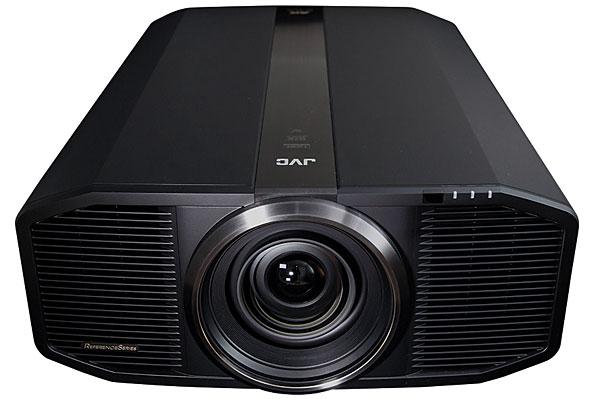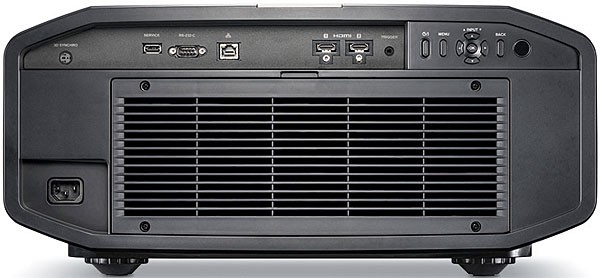JVC DLA-RS4500 D-ILA Laser Projector Review

AT A GLANCE
Plus
True 4K (4096 x 2160) D-ILA panels
Improved HDR support including HLG
Reference-quality optics
Minus
Fan noise can be intrusive
HDMI sluggish to sync
Native contrast not quite on par with rest of JVC line
THE VERDICT
While JVC’s first native 4K projector for consumers doesn’t quite deliver the contrast of its 1080p lineup, its projected image is breathtaking with both 1080p and 4K content. With its advanced laser light engine, reference-quality optics, and enough lumens to light up a massive range of screens, you have a true flagship-caliber offering from JVC.
While 4K has become the new norm for the flat-panel industry, its adoption into the home projection market has been slow, to say the least. Until now, Sony has been trailblazing native 4K for the consumer home theater market while others have offered quasi-4K options that use techniques to deliver near4K quality with 1080p imaging systems at more affordable pricing. Among those manufacturers, JVC led the way with their e-shift system, which over time has matured to contend quite convincingly with native 4K designs. But e-shift has always been seen as a temporary measure until the day we finally get true 4K D-ILA chips from JVC. Thankfully, that day has come with the company’s new flagship, the DLA-RS4500. This design is a departure from JVC’s projectors of the past, combining three new 4096 x 2160 D-ILA imaging chips with a laser light engine and a massive 18-element all-glass lens. At $35,000, it breaks new ground for JVC on pricing as well, but it actually offers stiff competition in its segment.
A Beauty of a Beast
If you only saw pictures of the DLA-RS4500, you might be fooled into thinking that it isn’t much different from the rest of JVC’s line. It shares some similar styling, but it’s a whole different beast that weighs in at 86 pounds and has a significantly larger chassis.
JVC is rightly proud of the 18-element, 16-group 100mmdiameter all-glass zoom lens, which was designed specifically for this projector. The company has always provided fantastic optics, but this design takes it to a new level. Pixel sharpness was nearly perfect from edge to edge on my screen, and the vertical blooming from bright objects on black seen from the less pricey JVC projectors has been eliminated. Color fringing was visible only on the most extreme edges of the test patterns I looked at, and only with my nose at the screen. Full motorized lens control (focus, zoom, and shift) is included, and once again JVC provides the best motorized setup I’ve used on a projector to date. Adjusting any of these settings is extremely intuitive, with steps allowing for unprecedented fine-tuning. Unlike JVC’s other consumer models, the DLA-RS4500 doesn’t include a motorized lens cover, but there’s a standard cover if needed.

The back panel is devoid of analog video inputs, offering only a pair of up-to-date full-bandwidth (18 gigabit-per-second) HDMI 2.0b ports with HDCP 2.2 copyright management. There’s a 3D sync port that works with both the IR and RF versions of JVC’s 3D emitters (sold separately). You’ll also find a trigger output, an Ethernet port, and an RS-232 port. But the most notable inclusion on the back panel is the new USB port for firmware updates, a feature that has been sorely missing from previous JVC offerings—and one I hope the company takes advantage of over the life of the design with upgrades.
Inside is a completely new second-generation laser light engine dubbed BLU-Escent. JVC has been using laser illumination in their professional projectors for the simulation market, and their experience there led to this new design for home theaters. The engine uses six independent light banks, each made up of eight laser diodes. Unlike Epson’s laser-based projectors so far, the diodes are replaceable if they fail or you manage to whittle them down to an output that you find unusable. [Ed. Note: See our review of the laser-driven Epson LS10500 on page 50.—RS] The light engine can be operated in three different levels for your desired brightness. Since laser engines are far more stable over time than traditional lamp-based designs (keeping most of their original brightness until failure), this allows you to light up a larger screen for a much longer period of time without having to worry about replacing a bulb as it dims, or performing frequent calibrations. JVC specs the life of the light engine at 20,000 hours at full laser power in the High mode.
The laser engine also has a dynamic modulation feature to increase perceived contrast and the black floor. Similar to a dynamic iris, this allows the projector to modulate the level of light on a frame-by-frame basis. The system offers two options, Mode 1 and Mode 2, with the latter being more aggressive. As with any dynamic contrast system, neither mode is 100 percent transparent, and I imagine your results will vary depending on just how sensitive you are to the artifacts as the system adjusts to different scenes. I got to the point where I left it off more often than not and engaged it only for films that I knew would be dark most of the time. But even in use, I didn’t find it overly intrusive, with only occasional image flickering as the picture brightness changed or very minor pumping on some opening credits, and this was less of a problem than with other dynamic iris systems I’ve used.
The dynamic laser did improve perceived contrast (and measured contrast) significantly enough to recommend its use by default until you find it bothersome. Hopefully, JVC will refine this technique over time to make it even more transparent. Unlike the Espon laser light engine I’ve reviewed, the one in the DLA-RS4500 won’t completely shut off the laser when it sees full black. That also means you won’t get the annoying, jarring jump from pure black to the native black floor of the projector.
Setup and Calibration
JVC has refined the setup process for this new projector compared with that of earlier models. While the menus are mostly the same, some of the labels are clearer. For instance, the color profiles are now appropriately named for the color gamut employed including BT.709 for HD material, BT.2020 for HDR, and DCI for professional applications. Gamma selections are easier, too, with options for standard 2.2 or 2.4 gamma curves as well as clearly labeled HDR (ST.2084 or Hybrid Log) gammas. There’s also a THX mode that shoots for a fairly calibrated picture for both 2D and 3D playback, but I found that the Natural preset did just as good of a job with standard HD playback.
The remote is nearly identical to those of previous models, but the buttons have been changed up to give better access to viewing modes and lens setups. The backlit design has always been easy to use, and overall it gets the job done.
As with most JVCs projectors I’ve used in the past, the out-of-box calibration wasn’t too far off, with only a minor touchup needed in grayscale to get things dialed in to reference-quality playback for standard HD material. You can find my exact user settings in the online version of this review. Little adjustment was needed to get an accurate picture.Standard settings for brightness and contrast were dead-on out of the box, and I was pleased to see that a brightness setting of 0 had no problem resolving near black (digital level 17). This has been an issue with recent JVC models. As before, you can select different HDMI picture modes that allow you to pick your clipping points. The Standard mode clips at digital 16 and digital 235 for standard video playback, while Super White clips at 16 and extends white to digital 255 if you prefer the headroom. Enhanced is offered for PC-based sources encoded from 0 to 255.
Along with the three selections for laser brightness mentioned earlier, the projector features a manual lens aperture for fine-tuning brightness and contrast even further. On my screen, in about the mid-throw zoom range, the projector could deliver 23 foot-lamberts in low mode, 41 ft-L in mid, and a blistering 53 ft-L in high mode with a calibrated image. The manual aperture is more aggressive than what we’ve seen in JVC’s standard models and, when fully closed, would bring those numbers down to 5, 9, and 12 ft-L, respectively. JVC claims a healthy peak brightness of about 3,100 lumens, and I was able to measure just under 2,900 in the High Bright settings, but calibrated lumens fell more toward about 2,500 lumens. Obviously this will vary a bit with how much zoom you use.
The laser light engine was probably my favorite feature overall—and I absolutely love the ability to turn the projector on and off anytime without regard to lamp health. The engine was also the source of my biggest complaint: noise. In the past few years, we’ve become accustomed to nearly silent projectors from Sony, Epson, and JVC. My reference projector is another JVC, the DLA-X750R. In low lamp mode, its fan is nearly undetectable, even with nothing else on in the room. But the noise from the DLA-RS4500 is noticeable even in low laser mode. It also has a scalable cooling system that will ramp up the longer you use it, so while it may start out pretty quiet, with extended viewing it will eventually get to the same noise level as found in a higher laser mode. How perceptible this is while you’re watching a movie depends on the volume of the soundtrack, obviously, but also on where you are in relation to the vents on the front. Thankfully, the noise isn’t mechanical in nature; instead, it sounds like air rushing, so it’s easily drowned out by most movies. At the tail end of my review period, JVC sent me their optional exhaust covers, which are designed to divert air away from the lens (if that is an issue in your room). A side benefit is they cut a little bit of the noise. While this didn’t completely eliminate the fan noise, it did dampen it somewhat in the higher laser modes (depending on your seating position in relation to the projector). I also found that careful placement of the projector so you are a bit out of the line of sight of the vents can help a lot, but JVC really needs to address the core issue in future models. As we’ve become so accustomed to nearly silent designs, it’s a hard sell for a flagship projector to be as noticeable as this one compared with lower-priced designs. Integrators using this in high-end installs might consider enclosing the projector in a ventilated compartment.
Excellent contrast with low black levels has always been the biggest claim to fame for JVC, with their current line offering the highest native contrast numbers I’ve ever measured for projectors. While the DLA-RS4500 obviously has more brightness firepower on board for driving very large screens, it unfortunately takes a pretty substantial dive in native contrast. Numbers for the new 4K panel, taken at about mid-zoom position, measured out around 9,000:1, with the highest native contrast (no laser dimming) achieved at about 28,000:1 in high lamp with the aperture fully closed down. Engaging the dynamic laser helped a lot subjectively, and measurements improved as well. I was able to achieve a peak contrast ratio of 150,000:1 in high laser with the aperture fully closed and dynamic laser engaged, but for normal viewing in my setup the contrast ended up around 80,000:1. This puts the contrast performance in line with the Sony VPL-VW665ES that I reviewed in our April 2016 issue. Overall, subjective contrast was quite good, though it did fall short of my reference DLA-X750R. Intrascene contrast didn’t have the inky blacks of that projector, but overall performance was still fantastic for all but the most demanding dark material.
























































